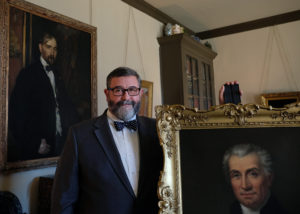Scott Harris ’83 got firsthand history lessons as a boy growing up in Staunton, Va. His grandmother, who was born in 1898, was a gifted storyteller who could transport Harris to life in Virginia at the turn of the 20th century. Historical sites were all around him. When Harris’ parents took him to the New Market Battlefield State Historical Park at age 9, he never imagined he’d grow up to be its director decades later.
Nor did he foresee returning to his alma mater, from which he received a B.A. with honors in history and historic preservation in 1983. In 2011 Harris became director of the James Monroe Museum, the world’s largest repository of artifacts and archives related to the nation’s fifth president. Earlier this year he was named executive director of University Museums, overseeing the James Monroe Museum, the Papers of James Monroe, and the Gari Melchers Home and Studio. In his new role, Harris remains focused on a mission that that has motivated his 30-year museum career: “Our job is to remind people today of the importance of those who went before them.”
Q: Tell us about your new role.
A: I get to advocate for the museums from a broader perspective. I help secure funding to keep the Papers of James Monroe active and figure out how we can best position the museums for the future.
Q: What’s your favorite part of the job?
A: Every day brings a new challenge. I get the opportunity to make a big impact on all these components of University Museums and hopefully help them thrive.
Q: What do the James Monroe Museum and Gari Melchers Home and Studio have in common?
A: James Monroe and Gari Melchers were well known and respected in their times, each at the top of his game, and yet they are not household names today. The challenge is to reintroduce them to the world.
Q: Why are these two people important?
A: James Monroe played a significant role in our early national history, from the Revolutionary War to the generation before the Civil War. Gari Melchers brought skill and passion not only to his own art, but also to advocacy of the arts generally. The contributions of both men are useful in providing artistic and cultural content to balance the contemporary emphasis on STEM education.
Q: How do the museums connect to the UMW community?
A: Mary Washington has administered both museums since the 1960s. While both relationships began as “marriages of convenience,” the museums’ affiliation with UMW, and that of the Papers of James Monroe, provide valuable learning labs for our students in history, historic preservation, museum studies, and other fields. Working with these entities allows students to hone practical skills that will help them in the future careers.
Q: What’s your favorite part of the Gari Melchers Home and Studio, and of the James Monroe Museum?
A: Melchers’ studio contains one of my favorite paintings of his, titled “In Holland.” Painted in 1887, it shows two young women crossing a field, one bearing two heavy buckets on a yoke. Their expressions convey a wealth of emotions. Melchers had a knack for making the ordinary extraordinary in his work. My favorite spot in the James Monroe Museum is in front of his large portrait painted by Rembrandt Peale around 1825. It shows Monroe at the end of his presidency and political career, and again, the expression on his face speaks volumes.
Q: Any mantras you tell yourself every day?
A: Don’t screw up
